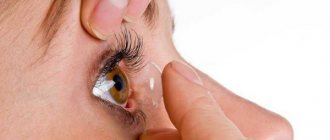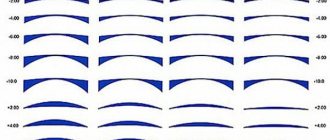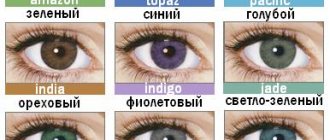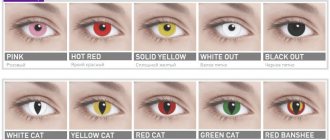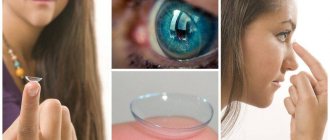When using contact lenses, it is important to comply with certain requirements. It seems that it could be simpler? Buy a CL, read the instructions and use it. But, often the instructions cover only the basic rules aimed at the safety and security of the lenses themselves. As for the personal health of patients, there are already a number of recommendations that are best followed. An ophthalmologist will teach you initial handling skills and he will also tell you what you should and should not do when wearing contact lenses.
Smoking ban
Staying in excessively smoky or gas-filled spaces is highly discouraged due to the ingress of tobacco tar, exhaust gases and other aggressive substances.
There are special tips when visiting: parking lots, areas with objects under construction, smoking areas, hairdressers and others where negative polluting factors are present:
- Use of daily disposable lenses.
- Use for cleaning peroxide products.
- Applying drops to the eyes during the day to further moisturize, cleanse and create a feeling of comfort.
How to get used to lenses
The cornea gets used to the eyepieces within a maximum of ten days, provided that you follow the wearing regime and do not walk around in them 24 hours a day. First, leave them for thirty minutes, then increase the operating period by half an hour every day. After six days, when the optics are on the eyes for more than three hours, the duration of wearing is allowed to be increased by one hour every day.
If you are forced to take a significant break from using the products, then most likely you will have to go through the habituation stage from the very beginning. Still experiencing discomfort after ten days? Most likely, the eyepiece model was selected incorrectly. To solve the problem, visit an ophthalmologist. He will recommend another manufacturer of contact lenses or advise you to stop wearing them altogether.
Monitoring your eye condition
The following symptoms should be alarming and be a reason to contact an ophthalmologist:
- Redness.
- Sensation of a foreign object inside that does not pass after removal.
- Burning, itching.
- Discharge.
- The emerging veil.
- Rainbow areolas close to lighting.
- Signs of pain.
- Fear of light.
- Tearing.
There is no point in continuing to use CL in the hope that the symptoms will go away on their own. It is best to temporarily switch to glasses. However, let’s not forget about emergency situations.
Rules for caring for contact lenses
In order not to encounter the development of serious pathologies and not to experience discomfort when wearing, you must follow several rules for caring for optical products:
- Do not forget to periodically update containers intended for storing CL;
- Before removing or putting on the lens, wash your hands well with soap and dry them. Of course, this will not help prevent infection from entering the eyes, but keep the product sterile;
- After using the eyepieces, do not immediately put them into a container; first, wash them on both sides with a special solution. Water is not suitable for these purposes; human saliva is even more unsuitable for cleaning optics;
- Products may only be stored in containers designed for this purpose. The container should also be rinsed with the solution;
- 100% disinfection of the optics occurs after four hours in the “jar”;
- For models intended for long-term use, clean them once every seven days with a special enzyme composition. To do this, place the tablet in the container, after it dissolves, place the lens in the liquid. Products for daytime wear are left on for a maximum of twelve hours. Products that are used around the clock are processed for one hundred and twenty minutes. After this, rinse the lenses with a clean solution.
Do not use the composition for storage several times; after a certain period of time, its properties are lost. It's inexpensive, so there's no need to skimp on the product! Planned replacement is also necessary for the container; buy a new container every three months. Return to contents
Dangerous situations
- Location under the upper eyelid, if you rub the eye too hard or if you remove it incorrectly, when the lens folds halfway. You should try to remove it from the eye yourself, after applying drops. Using massaging movements with the eyes closed, the lens moves through the upper eyelid.
- Static adhesion occurs when water gets into the eyes. It is forbidden to move the lens from its place, but wait until it is saturated with tears until it moves.
- Displacement on the sclera. Move it to the cornea by pressing on the lower eyelid.
That's all. Follow these simple recommendations and your eyes will thank you!
How to put on lenses correctly
Before putting on the product, wash your hands thoroughly with soap and dry them. To remove the optics from the blister, it is better to use tweezers. Place the CL on your index finger and make a visual inspection to make sure it has not turned out.
Pull back your eyelid and insert the lens. In this case, you do not need to look at the finger on which it lies. Do not under any circumstances confuse the plates for the left and right eyes; usually containers intended for storage have special marks.
Close your eyes and lightly massage your eyelid until the product snaps into place. It is better to perform the procedure while sitting at a table, so that the “plate” will not fall on the dirty floor and will not get lost in the “depths” of the carpet. You can manipulate the sink, just cover it with a disposable paper towel first. Return to contents
How to wear colored lenses for the first time?
Colored lenses are used to decorate the appearance. In terms of putting them on, they are no different from conventional optical contact lenses. There is a slight difference in putting on scleral type products.
The difference is due to their larger sizes. It is impossible to hold such a product on the tip of one or even two fingers, so you need to use three. Otherwise, there are no differences in putting on these optical devices.
PECULIARITIES! Lenses should be worn over a clean table. If you drop them, they will be easy to find. Manipulations with products should be done before applying makeup, so that particles of mascara or eye shadow do not get into the eyes.
How to put on lenses
How to properly put on contact lenses for the first time? Lack of experience will not affect the result if you are confident in your actions. The main thing is not to worry or be afraid. If it doesn’t work out right away, don’t be upset - rest and try later. If you follow the general rules there will be no problems .
Let's figure out how to wear lenses correctly . They can be:
- scleral;
- corneal.
Scleral
How to wear scleral lenses? CLs of this type are worn entirely on the sclera, that is, on the white of the eye.
After preparation, follow these simple steps:
- Take the lens from the container compartment with tweezers.
- Fill it with saline or other prescribed medication, holding it on two or three fingers of one hand.
- Spread the liquid to the edges to avoid getting any bubbles between the vision correction product and the eye.
- Bend your head over the mirror to avoid spilling the solution.
- Pull the upper and lower eyelids with your other hand and apply the lens to the eye.
- Rotate it in any direction. If she turns around calmly, then you did everything right.
- Next, repeat these manipulations for the other eye.
Corneal
Corneal lenses are smaller in size than scleral lenses and cover only the cornea of the eye. When purchasing contact lenses, an ophthalmologist can show you how to properly put on lenses for the first time. It is enough to adapt and this process will take no more than 30-40 seconds for both eyes.
Remove the lens from the container using special tweezers or a fingertip and place it on the index finger of your right hand (if you are right-handed). It is not recommended to remove it using your nails, as you may damage or tear the fragile product.
Check to see if the contact lens is inside out. To do this, just look at its shape; it should be an even bowl. If the bowl is curved, then it needs to be placed on the other side. Some contact lenses have symbols or numbers, by the direction of which you can also determine whether you are holding it on the right side. Corneal vision correction devices can be put on with one hand or two.
In the first case, hold the eyelid on the pad of the index finger of one hand, and pull the lower eyelid with your middle finger. Next, look up, apply the lens to the eye just below the pupil and slowly release the eyelid.
The second way to put on contact lenses is simpler. You hold the lens on the pad of the finger of one hand, and with the index and thumb of the other you pull down the upper and lower eyelids. Place the lens carefully on your eye.
You can keep your eyes closed for a few seconds while you experience discomfort, you can drip moisturizing eye drops. If the discomfort does not go away, then you should take off the contact lens and try to put it on again.
I would like to note that eye corrective products can be colored. They can not only help you see better, but also change eye color. Such lenses are also worn to hide iris defects. Colored lenses are cosmetic, tint, decorative, daily and reusable. How to wear colored lenses? They are dressed in accordance with the rules for the type of lens - scleral or corneal, which we described above. Color does not play any role in putting on, except for the location of the pattern, if there is one.
What you need to know about such lenses
The best monthly contact lenses are soft lenses with a wear period of thirty days. In the morning, a clean pair of lenses is put on, and in the evening it is removed, disinfected and sent to a storage container. One-month lenses do not need to be removed before going to bed, as they are reusable lenses.
Such contact lenses have become very popular due to their cost-effectiveness - long wear life, the package contains three or six blisters with lenses.
Other benefits of monthly lenses include:
- Optimal wearing period. Protein and fat deposits do not accumulate in excess over a month, so the lenses do not cause discomfort and are completely safe.
- The cost of the lenses is reasonable. On average, you can spend about one and a half thousand rubles for a package of six blisters (depending on the manufacturer).
- The material from which the lenses are made is absolutely harmless and does not cause discomfort to the eyes. It is sufficiently moistened, allows oxygen to pass through well and does not allow various deposits to accumulate on its surface.
- The optical power of the lenses has a wide range from +6.0 to -12.0 diopters, so they are perfect for correcting myopia, farsightedness and presbyopia.
- You can choose colored or tinted lenses. They can be used for both correction and normal vision.
Read how to wear two-week lenses here.
Who is recommended to wear monthly contact lenses:
- People who experience sediment accumulation as a result of tear fluid secretion.
- People who have suffered complications, such as conjunctivitis.
- For those who often lose or tear their lenses.
- People working in dusty conditions or in contact with chemicals.
How to remove optics
| This procedure must be approached responsibly; if you damage the plate, it cannot be used in the future. |
Observe the following sequence for removing the CL:
- First, set the location of the eyepiece. Ideally, it should be in the center of the cornea. If there is no lens there, then a displacement has occurred. Pull back the eyelid a little and look for the “loss”;
- Raise your gaze to the ceiling, carefully move the optics down;
- Connect your index and middle fingers like tongs;
- The lens should move away from the cornea and hang on your fingers.
If the product has moved and you cannot independently determine its location, immediately contact the clinic for help.
Tips for lens wearers
We recommend using simple tips to help protect your eyes from inflammation of the cornea:
- Never reuse the solution.
- Change your lens case monthly.
- Minimize contact of lenses with water: remove them before swimming or visiting the bathhouse.
- Do not wet the lens with saliva: it contains bacteria.
- Do not use water (even distilled water), saliva, or any other liquid that is not specifically designed for storing contact lenses.
- Make sure that no dirt gets into the solution bottle: do not leave it open, screw the bottle cap tightly after use.
- Do not mix different brands of lens care liquids.
- Keep the lens case (and other accessories) clean and change it frequently, at least once every three months. Do not let other people (even your loved ones) use your lens storage container.
- Change lenses according to your lens replacement schedule.
- Don't sleep in daily contact lenses.
- It has been proven that smokers who use contact lenses are more likely to suffer from eye diseases than non-smokers. It's better to give up this habit. But if you are not ready for such a step, then take care of your contact lenses very carefully.
How can soft contact lenses help with astigmatism?
Read what a toric intraocular lens is here.
How to use daily lenses:
Conclusion
Knowing how to properly use eye lenses will help you avoid many problems with your vision. All recommendations for storage and wearing should be strictly followed. At first, it may be difficult to put on and take off the eyepieces, but after you get the hang of it, this procedure will take a few minutes. Remember that if beauty requires sacrifice, then health needs your care and attention.
From the video you will learn how to properly remove and put on contact lenses
Return to contents
General recommendations for wearing lenses
Beginner users of contact correction should remember that during the first two to three weeks the eyes go through a stage of adaptation to the lens.
No matter how perfect a contact lens is, it is still a foreign body for the eye. In addition, when wearing lenses, tear production changes, and local reactions of eye tissue to the lens may appear. In the first days, it is not recommended to wear lenses from morning to evening. It is better to gradually increase the wearing time. You should not sleep in lenses unless they are new generation models - silicone hydrogel lenses. But even with extended-wear silicone hydrogel lenses, it is better to walk only during the day: it is safer for the eyes.
You should not wear lenses during a cold (flu, acute respiratory infection) or inflammatory eye diseases (conjunctivitis, blepharitis, etc.). When visiting the pool, wear safety goggles. If water gets under the lens, remove it immediately.
Eye care
Not only contact lenses, but also the organ of vision require special attention. To avoid eye diseases and other unpleasant situations, use a number of medications:
- Blepharolosion with chamomile or green tea extract. It tones the eyelids, improves hemodynamics and metabolism, and cleanses the glands. Use the product to make compresses, they will relieve dry eye syndrome, eliminate inflammatory processes and normalize tear production;
- Blefarogel with aloe extract and hyaluronic acid. It is applied to the eyelids with light massage movements. As a result, blood flow is activated, fatigue disappears and the functioning of the lacrimal glands is normalized;
- Blepharoshampoo. A hypoallergenic product for cleansing the eyelids, which contains olive oil, green tea and chamomile.
Those who use contact lenses should adhere to the following eye care regimen:
- Remove the optics, place in a container, treat the eyelids with “Blepharoshampoo”;
- Make a moisturizing compress from Blepharolotion;
- Perform a light massage with Blepharogel;
- Put on lenses if necessary.
How to remove the lens and check the inversion indicator
The container consists of two tightly sealed containers, marked “R” and “L”. “R” holds contact lenses intended to be worn in the right eye. “L” - for wearing CL in the left eye.
Take it out of the container with tweezers and place it on the pad of your index finger. If it is turned out, this is an incorrect position.
A special indicator, 123, is also applied to the optical aid. They are necessary to determine the correct position and orientation of the vision correction aid. If the product is turned inside out, the indicator is read in reverse order (321).



